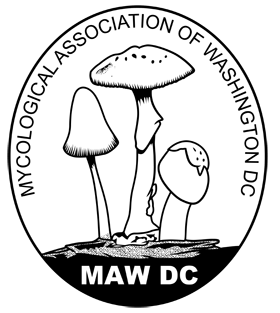 |
THE MYCOLOGICAL |
|---|---|
ASSOCIATION OF |
|
WASHINGTON, DC |
The following is a list of Fungal DNA Sequencing Protocols:
- Fieldwork
- Post field:Pre DNA extraction sample processing
- DNA Extraction, Amplification (PCR) and gel electrophoresis (Sigma Extract N Amp DNA extraction)
- DNA Extraction, Amplification (PCR) and gel electrophoresis (NaOH/Tris DNA extraction)
- Dry sample for long term preservation
- Send sample for sequencing
- Adding and editing a barcode on iNaturalist
- Blast Sequence
- Build phylogenetic tree
- Submit to Genbank
- Submit sample to herbarium
The MAWDC Fungal DNA Sequencing group is a collaborative team of MAWDC members who use polymerase chain reaction (PCR) to amplify fungal DNA sequences for taxonomic identification. MAWDC's annual budget provides sufficient funding for the team to process a nontrivial number of fungi each year so we can better understand the fungal biodiversity of our region.
For an introductory video of field collection best practices, try this video, or for detailed overview of fungal DNA sequencing, check out this wonderful video by Damon Tighe, or this one by Sigrid Jacob. This video by Everymanbio is well worth viewing too.
In this document, also by Sigrid Jacob, you'll find specific protocols for DNA Sequencing, and this photo document by Alan Rockefeller is another good source of information. For shorter and more specific videos, check out Sigrid Jacob's youtube channel.
Phylogeny Chart for the Fungal Tree of Life courtesy of Jacob Kalichman
Link to the file above: _Kalichman-foray2.pdf
HELP US UNDERSTAND THE BIODIVERSITY OF FUNGI IN THE GREATER WASHINGTON DC REGION BY BRINGING SAMPLES TO OUR LAB DAYS AT MOUNT RAINIER NATURE CENTER!
MAKING AN OBSERVATION
PHOTOGRAPH BEFORE DETACHING!
- Take more than one picture
- Show where the fungus is growing from (substrate)
-
- If attached to something living, identify as much as possible. Ex: conifer, deciduous, oak, american holly, etc.
- Photograph the habit (growing alone, gregarious, in clusters, etc.)
- Take a picture from the top
DETACH
- Take a picture of the underside
- Cut through the spore producing surface and notice if there are changes in color or secretion of latex. If so annotate and photograph
- Add any smell or bruising you observe in the section notes
PREPARING SAMPLE FOR DNA EXTRACTION
- Place the mushroom on a coffee filter, piece of paper, or wax bag
- Write the voucher information: date of collection, location, name of collector, field ID (Russula, Bolete, Agaricus, etc) and iNaturalist observation number.
- Place your sample inside its voucher bag in a dehydrator at 100° until it is dry as cardboard. The timing of his process will vary depending on the size of the mushroom.
-
- If you don’t have a dehydrator, you can place the mushroom in your oven using its lowest setting and leaving the door of the oven cracked with a clothespin. Check on this setting every hour to prevent burning or cooking the specimen.
- Once the specimen has been dried, wait for it to cool to room temperature and place the voucher bag and the mushroom inside in a closed ziplock bag to prevent rehydration with humid air.
In the link below you’ll find the slideshow used for the training on how to make observations and how to label your sample bag to serve as a voucher as well.
We will receive your properly documented sample with our deepest gratitude
We are excited to see you there!
-Serenella Linares, Programs Chair & Megan Romberg, Science Advisor
The Mycological Association of Washington, Inc.